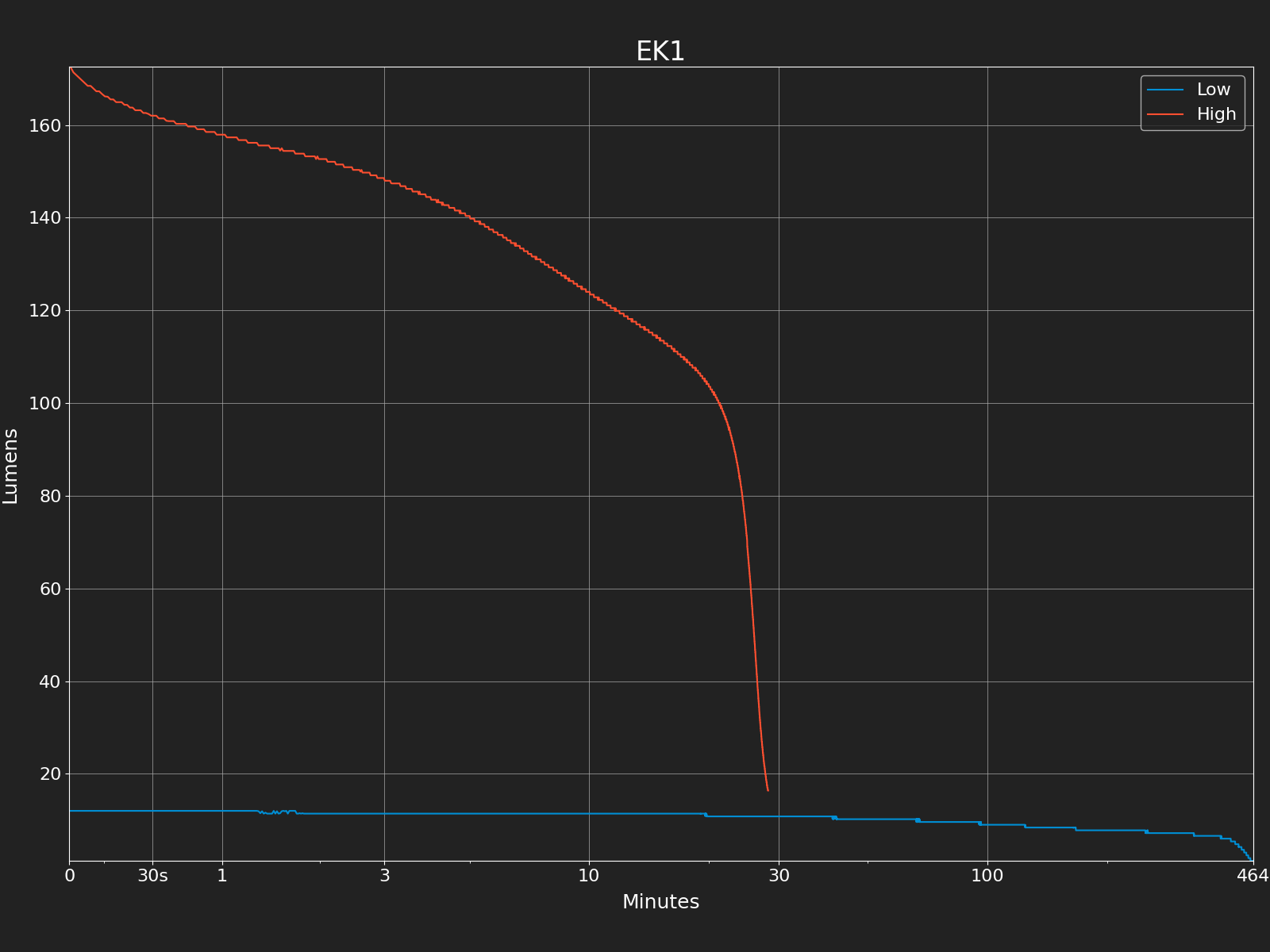This Skilhunt EK1 (affiliate link) was provided by Skilhunt for review.
Overview
The Skilhunt EK1 is a keychain flashlight with USB-C charging optional high-CRI, and a two-position twist switch. It resembles the previously popular CooYoo Quantum and similar lights from other brands, but has a larger battery and modern charging. Unfortunately, the battery is not field-replaceable.
It won't be a surprise to most people who have read my articles in the past that the low-CRI SST-20 is not the LED option I would recommend here. It is extremely green and does not have an output advantage that would justify giving up the color quality.
For those who want a small keychain light, the EK1 is Conditionally Recommended with the high-CRI LED option.
Specifications
| Spec | - |
|---|---|
| Battery | 1x10220 |
| LED | SST-20, 219F |
| Color temperature | 6329K |
| Color rendering index | 69 |
| Max output | 162 lm |
| Max throw | 60 m |
| Max sustainable output | n/a |
| Best efficiency | 122 lm/W @ 12 lm |
| Candela per lumen | 5.6 (floody) |
| Length | 50.5 mm |
| Head diameter | 14.6 mm |
| Weight | 14.8 g |
| Charging | USB-C |
| Low Voltage Protection (LVP) | No |
| Lockout | No |
| Approximate price | $19 |
| Rating | ★★★☆☆ (conditionally recommended) |
Highlights
- Compliant USB-C (use any power supply)
- Larger battery than many competitors
- Optional high CRI
Lowlights
- Battery is not field-replaceable
- No low-voltage protection
- No moonlight mode
Details and technical analysis
Versions
The EK1 comes in red, blue, green, and orange with a choice of low-CRI SST-20 or high-CRI 219F LEDs. This is the orange, SST-20 version.
Accessories
The EK1 comes with a USB-A to USB-C cable, keyring, and spare O-rings
Modes and user interface
| Mode | Estimated lumens | Estimated throw (FL1 meters) |
|---|---|---|
| Low | 12 | 14 |
| High | 162 | 60 |
The EK1's user interface is very simple: tighten the head to turn on low; tighten more for high.
Output, runtime, and efficiency
| Mode | Estimated lumens |
Time to 80% | Time to 50% | Time to 10% | Efficiency (lm/W) |
Current (mA) |
|---|---|---|---|---|---|---|
| Low | 12 | 95 minutes | 6.8 hours | 11.0 hours | 122 | |
| High | 162 | 7.9 minutes | 24 minutes | 36 minutes | 109 |

Light quality
Readings are taken from the center spot diffused with DC Fix diffusion film using an X-rite i1Pro spectrophotometer.
| Mode | Color Temperature |
Tint Duv | CRI | CRI R9 (deep red) |
CRI R12 (deep blue) |
|---|---|---|---|---|---|
| Low | 5628K | 0.0162 (2x extremely green) | 68.2 | -58.3 | 35.0 |
| High | 6329K | 0.0099 (extremely green) | 69.1 | -45.9 | 39.2 |
Beamshots
EK1 vs Zebralight SC64c LE and BLF 348
Note the Zebralight SC64c LE used for reference here is a much larger and more poweful light. It's my standard reference for everything even though a comparison would be unreasonable.
Low, high, SC64c LE
Batteries and charging
The 10220 Li-ion battery is not field-replaceable. Its capacity is listed at 130 mAh. That's larger than many competitors in this segment, as the previous common battery was a 10180 with a capacity of 80 mAh. Charging is via USB-C, and C-C cables do work. It takes about 90 minutes to charge from empty.
With a bit of wiggling and tugging, the head comes off the battery compartment. Some pulling on a plastic retaining clip with tweezers allows removal of the charging pill and battery. I did not find reliable suppliers for batteries in this size with a quick web search, though there are some sellers offering them on Aliexpress.
Size and ergonomics
The EK1 is about half the length of an AAA light, allowing it to go nearly unnoticed on most keyrings.
Modification potential
Removing a pair of tiny screws inside the head grants access to the MCPCB, which also has some resistors on it to serve as the EK1's driver. Swaps to other 3V 3535 size emitters are possible, though it's more challenging to reflow than a standard MCPCB. I put a high-CRI SST-20 in mine.
















Comments
You can use your Mastodon or Lemmy account to reply to this
Reply Reply
Reply
Loading...